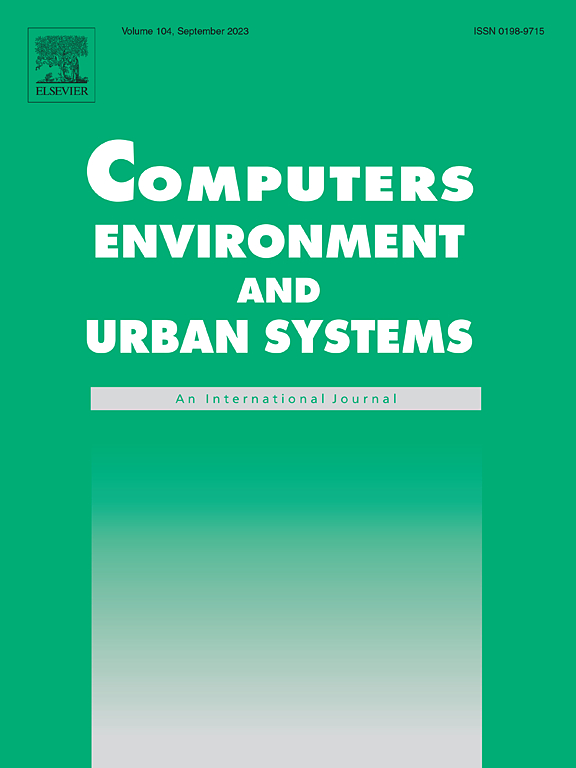基于小区形态聚类和区位吸引力分析的小区尺度人口估计模型
IF 7.1
1区 地球科学
Q1 ENVIRONMENTAL STUDIES
Computers Environment and Urban Systems
Pub Date : 2025-02-18
DOI:10.1016/j.compenvurbsys.2025.102257
引用次数: 0
摘要
在许多地区,城市化已经发展到需要城市更新的阶段,精确的人口数据对于有效的区域更新和可持续发展至关重要。因此,本文旨在将街道级(区下的行政单位)人口普查数据分解到地块级。从城市形态学角度出发,采用高斯混合模型(GMM)聚类算法对居住地块的形态进行分类,并为每一种类型分配一个类型参数:人均住房面积,以描述不同类型之间的人口密度差异。然后,我们使用Pearson相关分析来评估不同带宽下POI密度与人口密度之间的关系,确定不同POI类型的最佳带宽,并计算每个地块的总体POI密度,以评估其位置吸引力。利用人均住房面积、POI密度和总建筑面积建立回归模型,推导人口权重层,估算地块人口。精度评价结果表明,利用形态类型参数可以有效提高样地尺度上的估算精度,特别是在土地利用模式多样、人口密度较低的地区。然而,我们优化的位置吸引力计算方法仅比使用固定带宽的方法略有改进。本研究发展了基于形态分类的更精确的小区级人口估计方法,并突出了不同类型住宅小区的人口分布特征,有助于城市决策者制定有针对性的住房优化和社区资源配置策略。本文章由计算机程序翻译,如有差异,请以英文原文为准。
Plot-scale population estimation modeling based on residential plot form clustering and locational attractiveness analysis
In many regions, urbanization has advanced to a stage that requires urban renewal, making precise population data essential for effective regional renewal and sustainable development. Therefore, this paper aims to disaggregate Jiedao-level (an administrative unit under the district) census population data to the Plot level. From an urban morphology perspective, the Gaussian Mixture Model (GMM) clustering algorithm was applied to classify the form of residential plots, assigning a type parameter for each type: the per capita housing area, to describe population density differences among the types. We then used Pearson correlation analysis to assess the relationship between POI density and population density at various bandwidths, identifying the optimal bandwidth for different POI types and calculating the overall POI density for each plot to evaluate its locational attractiveness. A regression model was established using per capita housing area, POI density, and total building area to derive population weight layers for estimating population at the plot level. The results of accuracy assessment show that using the morphological type parameter can effectively improve the estimation accuracy at plot scale, especially in areas with diverse land-use patterns and lower population density. However, our optimized locational attractiveness calculation method shows only a slight improvement to the method using a fixed bandwidth. This study develops a more accurate population estimation method of plot-level based on morphological classification, and highlights the population distribution characteristics of different types of residential plots, aiding urban decision-makers in developing targeted strategies for housing optimization and community resource allocation.
求助全文
通过发布文献求助,成功后即可免费获取论文全文。
去求助
来源期刊

Computers Environment and Urban Systems
Multiple-
CiteScore
13.30
自引率
7.40%
发文量
111
审稿时长
32 days
期刊介绍:
Computers, Environment and Urban Systemsis an interdisciplinary journal publishing cutting-edge and innovative computer-based research on environmental and urban systems, that privileges the geospatial perspective. The journal welcomes original high quality scholarship of a theoretical, applied or technological nature, and provides a stimulating presentation of perspectives, research developments, overviews of important new technologies and uses of major computational, information-based, and visualization innovations. Applied and theoretical contributions demonstrate the scope of computer-based analysis fostering a better understanding of environmental and urban systems, their spatial scope and their dynamics.
 求助内容:
求助内容: 应助结果提醒方式:
应助结果提醒方式:


